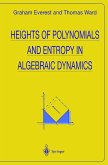Arithmetic geometry and algebraic dynamical systems are flourishing areas of mathematics. Both subjects have highly technical aspects, yet both of fer a rich supply of down-to-earth examples. Both have much to gain from each other in techniques and, more importantly, as a means for posing (and sometimes solving) outstanding problems. It is unlikely that new graduate students will have the time or the energy to master both. This book is in tended as a starting point for either topic, but is in content no more than an invitation. We hope to show that a rich common vein of ideas permeates both areas, and hope that further exploration of this commonality will result. Central to both topics is a notion of complexity. In arithmetic geome try 'height' measures arithmetical complexity of points on varieties, while in dynamical systems 'entropy' measures the orbit complexity of maps. The con nections between these two notions in explicit examples lie at the heart of the book. The fundamental objects which appear in both settings are polynomi als, so we are concerned principally with heights of polynomials. By working with polynomials rather than algebraic numbers we avoid local heights and p-adic valuations.
From the reviews:
"At first sight it would seem exceedingly unlikely that there would be any relation at all between entropy and height. Reality is otherwise: they are very much intertwined, and this is what this unusual and very interesting book is about. ... The authors write about all this with erudition and charm ... . They have included more than a hundred exercises ... ."
(M. Hazewinkel, Nieuw Archief voor Wiskunde, Vol. 5/6 (3), 2005)
"It ranges through a number of topics, varying from the elementary to the sophisticated, all featuring polynomials. ... this text provides an excellent basis for a beginning postgraduate course, since most of the material is not too demanding and yet it arouses the curiosity to learn more about dynamical systems, algebraic number theory or primality testing. In addition, there are 103 exercises with hints, five useful appendices sketching the prerequisites, and an extensive bibliography ... ."
(Victor P. Snaith, Bulletin of the London Mathematical Society, Vol. 32, 2000)
"This book provides an introduction to algebraic dynamical systems and their connection with number theory. This relationship is illustrated by many examples ... . I recommend the reading of this interesting book, which may be accessible even for advanced undergraduate students."
(Yann Bugeaud, Mathematical Reviews, Issue 2000 e)
"This unusual book is based on a course given to postgraduate students at the University of East Anglia. It could serve as a textbook or as interesting supplementary reading for a course in algebraic dynamics or elliptic curves. ... the authors follow the sound pedagogical practice of giving detailed proofs of special cases and providing references to the literature for more general results."
(D. W. Boyd, Zentralblatt MATH, Vol. 919, 1999)
"This monograph explores two notions of height in the context of dynamics: Mahler measure and elliptic height. ... the material of the book is very well presented and the historical references, examples and exercises make it a useful text for anybody trying to get into the spirit of algebraic dynamical systems."
(K. Schmidt, Monatshefte für Mathematik, Issue 3, 1999)
"At first sight it would seem exceedingly unlikely that there would be any relation at all between entropy and height. Reality is otherwise: they are very much intertwined, and this is what this unusual and very interesting book is about. ... The authors write about all this with erudition and charm ... . They have included more than a hundred exercises ... ."
(M. Hazewinkel, Nieuw Archief voor Wiskunde, Vol. 5/6 (3), 2005)
"It ranges through a number of topics, varying from the elementary to the sophisticated, all featuring polynomials. ... this text provides an excellent basis for a beginning postgraduate course, since most of the material is not too demanding and yet it arouses the curiosity to learn more about dynamical systems, algebraic number theory or primality testing. In addition, there are 103 exercises with hints, five useful appendices sketching the prerequisites, and an extensive bibliography ... ."
(Victor P. Snaith, Bulletin of the London Mathematical Society, Vol. 32, 2000)
"This book provides an introduction to algebraic dynamical systems and their connection with number theory. This relationship is illustrated by many examples ... . I recommend the reading of this interesting book, which may be accessible even for advanced undergraduate students."
(Yann Bugeaud, Mathematical Reviews, Issue 2000 e)
"This unusual book is based on a course given to postgraduate students at the University of East Anglia. It could serve as a textbook or as interesting supplementary reading for a course in algebraic dynamics or elliptic curves. ... the authors follow the sound pedagogical practice of giving detailed proofs of special cases and providing references to the literature for more general results."
(D. W. Boyd, Zentralblatt MATH, Vol. 919, 1999)
"This monograph explores two notions of height in the context of dynamics: Mahler measure and elliptic height. ... the material of the book is very well presented and the historical references, examples and exercises make it a useful text for anybody trying to get into the spirit of algebraic dynamical systems."
(K. Schmidt, Monatshefte für Mathematik, Issue 3, 1999)








